The Illiotibial Band is a vital part of the leg but troublesome—unless you take care of it. Simon Vincett and Andrew Pell show you how.
Many bike riders will be familiar with pain in the outside of the knee. This is most likely ‘ITB syndrome’ or inflammation from friction of the tough fascia (connective tissue) of the Illiotibial Band rubbing across a point of bone. It’s a repetition injury and can happen at the upper thigh but most commonly happens at the outside of the knee.
Once the ITB is inflamed it is painful to bend your knee and takes weeks or months to calm down. There’s not much to do except rest it, which is frustrating if bike riding is your way to get around. What you can do, however, is prevention. The following stretches and strengthening exercises are really worthwhile for anyone, whether you’ve had ITB pain before or not.
The ITB is a thick band of fascia (inner muscle) and, therefore, it doesn’t contract. Tightness through the gluteus maximus (bottom), tensor fascia latae (hip) and vastus lateralis (quads/outer thigh) can all contribute to ITB friction syndrome as these muscles directly feed into the ITB.

In daily life you can tone all the leg muscles quite effectively by standing on one leg as often as possible and in a variety of postures. Try work at a standing desk for a few sessions a day and spend time on one leg. In any queue, alternate between standing on one leg and then the other. You have to be free balancing or only slightly supported for balance for this to be effective. Train yourself to alternate between feet you put down off the pedal when stopped at the lights.
Rolling with a foam roller is also helpful to achieve maximum lengthening of these muscles. For ITB benefit, focus on rolling the tensor fascia latae, gluteus maximus and the full length of the ITB and vastus lateralis.
If your ITB is inflamed or painful, it is recommended a visit to an osteopath, myotherapist or physiotherapist for further investigation, including checking your bike set-up and pelvic stability and alignment.
Reclining hip stretch
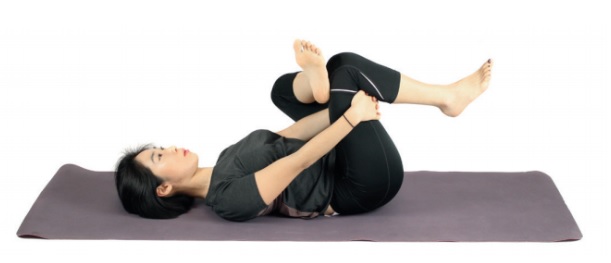
Lying back, place your right foot, just below the ankle, above the left knee. Bring your left knee towards your chest and clasp your hands behind the knee. Feel the right thigh rotate away as the knee swings out wide. Gently draw the left knee towards you to increase the stretch.
Hold for three to five minutes, then repeat for the other side.
Reclining knee-across stretch
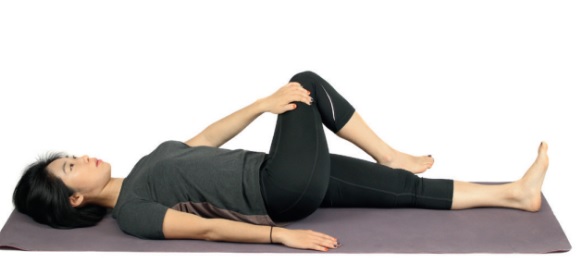
Lying back with legs straight, bend your right leg and place your right foot outside your left knee. Now take your right knee towards the ground. Your right foot does not have to stay on the ground. Use your left hand to encourage your right knee down. It will be just below hip level. Hole for one minute.
Now draw your right knee slightly higher than hip level and gently pull it down with your left hand. Hold for one minute.
Repeat these with the left leg.
Clam and leg raises
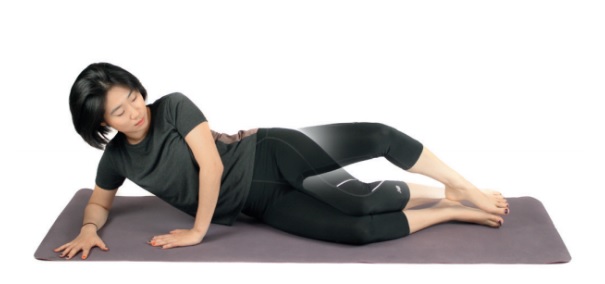
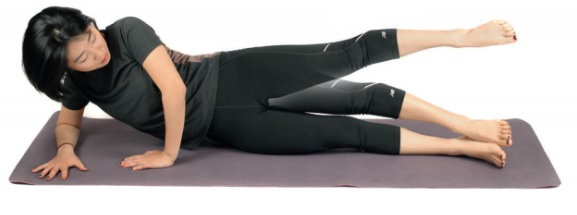
Lying on your right side, bend your knees slightly. Open your knees as wide as possible and close again. Repeat 10 times and swap to your left side to do the other leg.
Now lying on your right side again, align your hips and shoulders as vertical as you can keep them. Hold and raise the right foot sideways keeping the feet parallel at all times. Do this 10 times and then do 10 with the right leg.
Low static lunge
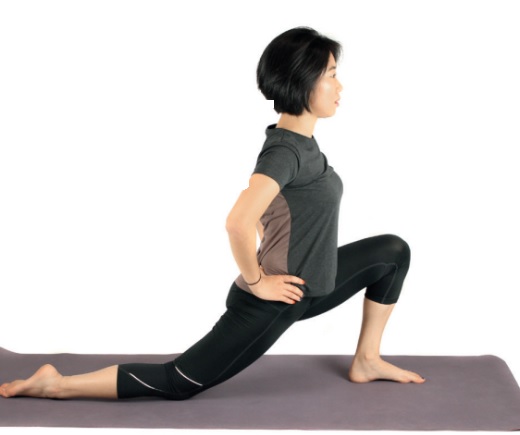
From standing, take a big step forward with your right leg, bend your knee and take your left knee to the ground. Lay the top of your left foot and your shin flat on the ground and lunge the right knee forward over the right foot. You’re trying here to close the gap between right hamstring and calf. Keep the left hip lunging forward at the same amount as the right hip. Pressing down through the top of the left foot and rotating the outside left thigh forward helps with this. Your right knee shouldn’t sway out to the side—your thigh should be vertically over your foot.
Hold for ten breaths and swap legs to do the other side.
Standing quad stretch
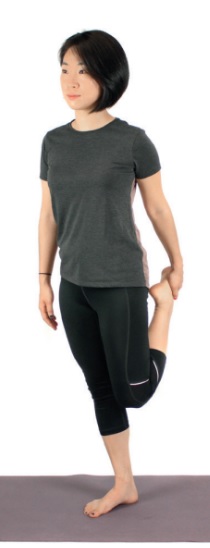
Standing, bend your right leg and clasp your ankle or foot. Draw the foot towards the outside of your buttock. Try to work your right knee level with, or behind, the standing leg knee to stretch into the top of the quad too.
Hold for ten breaths, then alternate sides. Do both sides twice.
Activating the inner quad
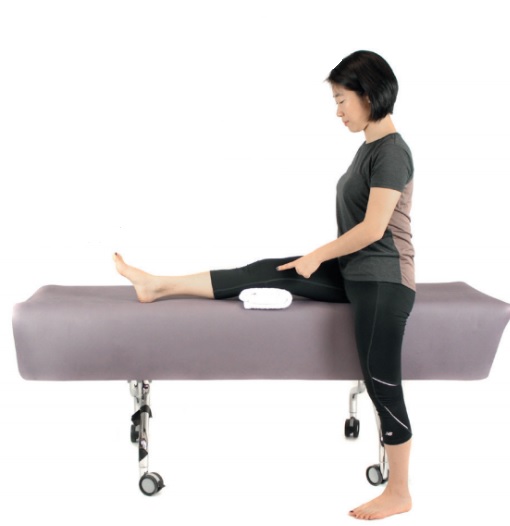
The muscle firing pattern of your quadriceps can become out of sync with the outer side contracting first and becoming a lot stronger than the inner (vastus medialis oblique).
Lay your leg along a table with a small rolled towel under the knee. Put your finger on the vastus medialis oblique and push your inner knee down into the towel to feel it contract. Hold five seconds, repeat five times and then repeat with the other leg.
Tree to the wall
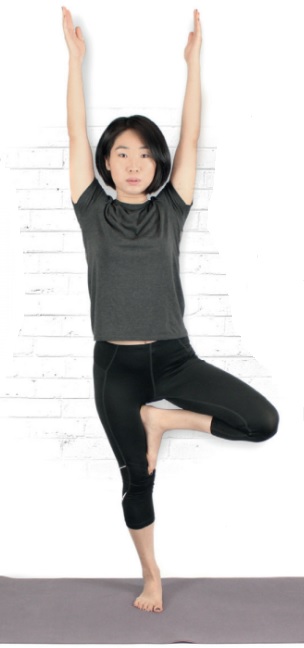
Standing with your back and heels against the wall, rotate the inner thighs back to broaden and lift the hamstrings to bring them towards the wall. Holding that lift, bend the right knee, swing it to the side and place your foot on the inside of your left thigh (or knee). Keep the left hamstring towards the wall and keep the hips level and raise your hands straight up above your shoulders.
Hold for ten breaths, then alternate sides. Do both sides twice.
Warrior 3
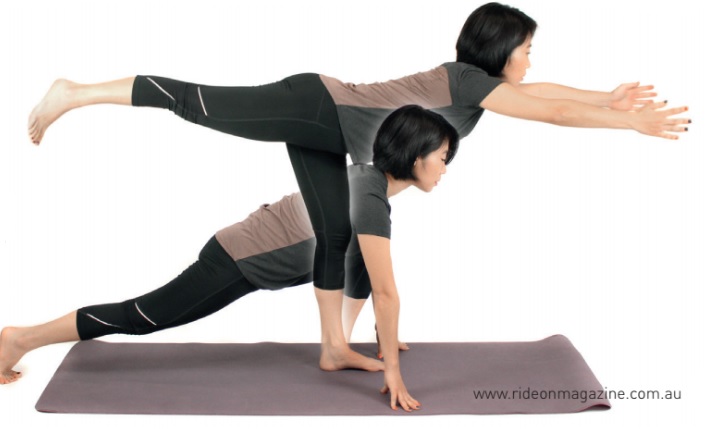
Stand with plenty of space around you and both feet together. Step your left foot far back so that your right thigh becomes parallel to the ground and at a right angle to your lower leg. Lay your torso down along your right thigh and keep your left leg straight, resting on your toes. Pressing through your right heel, extend your arms level with the ground, straighten your right leg to stand and lift your left leg to be level with the ground. Aim to have your shoulders and hips level with the ground.
Hold for ten breaths, then alternate sides.
Photography Karl Hilzinger
